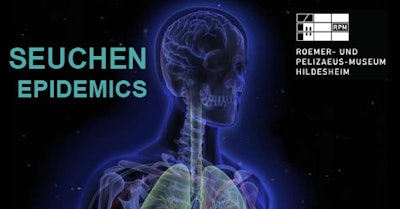
The Roemer- und Pelizaeus-Museum is an archaeological museum in Hildesheim, Germany. Its upcoming special exhibition -- "Epidemics: Curse of the Past, Threat to the Future" -- will trace the history of epidemics through the centuries and offer a glimpse of the future.
This will be the biggest ever special exhibition on the topic, and it was planned long before the outbreak of COVID-19. The eye-catching poster reminds me of medical imaging.
 The exhibition is due to run from 2 October 2021 to 1 May 2022.
The exhibition is due to run from 2 October 2021 to 1 May 2022.Radiology is the interdisciplinary crossroads for most medical specialties, from traumatology to cardiology. There is one exception: In general, very few high-technology examinations are requested by the infection wards. In radiology, therefore, there has been very little contact with the specialists in infectious diseases, and often, radiologists have only limited knowledge of these diseases.
Anyhow, if physicians dealing with infectious patients want to refer someone to radiology, there is always trouble and discussion in contagious cases because imaging facilities have to be closed and disinfected after the examination. Usually today, these wards have their own mobile imaging systems allowing plain imaging of their patients.
The worldwide extent of infectious diseases is difficult for us to imagine. In the late 19th century, or even as recently as 80 years ago, the situation was different. In 1892, 21% of the German population died of infectious diseases, and even in 1920, the figure was 13.6%. The percentage of deaths dropped to 0.83% 60 years ago, and to 0.78% by 1987.
In the years before World War I, the slums of London and many other big cities all over Europe were characterized by dirt, drunkenness, terrible poverty, and exploitation. One in three infants died before reaching their first birthday. After the introduction of medical examinations at schools, it was reported that nearly 20% of the children were unfit to be taught because they suffered from worms or other infectious diseases.
Resurgence of tuberculosis
Tuberculosis (TB) was one of the foremost and most feared killers. In a treatise on climatic health resorts published in the mid-19th century, the author underlined that at least 25% of the customers of pharmacies suffered from "phthisis" (i.e., pulmonary TB or a similar progressive wasting disease) and recommended moving to Madeira as a possible remedy.1,2
Improved sanitary and living conditions and better medicines -- in particular antibiotics -- developed after the First and Second World Wars changed this situation. In Europe and parts of North America, the incidence of TB declined steadily from the 1930s until the 1980s.
Cavities in the lungs may form quite early in TB. Reading chest x-rays, looking for single cavities or diffuse spread, typically constituted a major, albeit rather boring, daily task for a radiologist even 60 years ago. Fluoroscopy and x-ray population screening became a core element of radiology between the 1930s and the late 1970s, by which time TB was finally considered to have been almost eradicated in Europe. Although it was no longer deemed a threat to mankind, the disease still remains a marker of poverty and social decline.
Today, we once again see a rapid increase in TB, most dramatically in large U.S. cities, but also in France, U.K., and parts of Central and Northern Europe.
TB is primarily seen in immigrants, but it is also connected to HIV infection. In one Northern European country, 5% of the immigrants proved positive for TB in the late 1970s; 25 years later, that number climbed to 40%. The worldwide situation looks even worse. The tuberculosis bacterium has infected at least 1.75 billion people; of the millions of people who die every year all over the world, some 2% to 5% die from TB. It is the leading killer among infectious diseases. In comparison, less than 2% die from malaria.
As with many other contagious diseases, most cases of TB occur in developing countries, as nowadays malaria does too. Overpopulation, lack of water, and poor hygiene in many parts of the world, as well as the general absence of or the failure to realize health programs, are the cause of the increased incidence of contagious diseases.
Traveling adds to the problem, but the single most important factor behind the resurgence of TB is the worldwide spread of AIDS -- a disease that often accompanies TB infection and of which TB may well be the first sign.
Tropical diseases
It should not be forgotten that there are many tropical or "exotic" diseases. Among those that are almost unknown to Europeans but are not exclusive to the tropics is amoebiasis. Many radiologists are familiar with the name of the disease, but have you ever seen an ameboma? When performing abdominal imaging, it can look like a carcinoma constricting the colon.
The World Health Organization (WHO) estimates that some 200 million people, most of whom live in tropical and subtropical countries, are infected with bilharziasis, or schistosomiasis. This infectious water-borne disease is transmitted by snails carrying the parasitic flatworm that causes it. Once bilharziasis is established in an area, it is virtually impossible to eradicate -- and the disease is on the rise in many regions of Africa.
As with TB, at least one-quarter of the world's population suffers from ascariasis. The roundworm Ascaris is the most common cause of jaundice in children all over South America, Africa, and Asia.
The round dance of infectious diseases continues with echinococcosis, trypanosomiasis, typhoid, leprosy, and, of course, malaria. When I attended a course on tropical diseases as a medical student, the professor pointed out that actually, most of these diseases are exotic rather than tropical -- because they are exotic to us and extinguished in most of Europe. But malaria was found in England, Italy, southern Switzerland, and even in the Baltic States not so long ago. The last epidemic in Germany was in a region in the northeast of the country in late summer 1946 -- 6,000 cases within a month. Leprosy was also widespread all over Europe. Geographical names such as Rosenheim, a town close to Munich, are proof of it; the name Rosenheim has nothing to do with roses, as the local tourist board claims, but rather means "leprosarium."
Role of radiology
Let's return to radiology. Although the diagnosis of infectious diseases is not a primary indication of diagnostic imaging in Europe, radiologists are increasingly performing examinations of immigrants and travelers returning from the tropics. Plain x-rays, ultrasound, and other basic imaging examinations are helpful in primary diagnosis and follow-up. CT and MRI are useful in the diagnosis of a limited number of these diseases, such as cysticercosis, particularly if cerebral or spinal affections are being investigated.
Sometimes, when you read images with changes or lesions inexplicable to you and there is no proper medical history on the referral sheet, you should think twice and ask the patient, "Have you been abroad?"
Patients might not mention recent travels to the referring physician because they may not consider it pertinent. With many parasites or infections, there is a delay before symptoms of the disease occur, and I have seen a number of cases in which the radiologist directed the referring physician toward the diagnosis of a tropical disease.
In spite of this, radiography or other imaging methods are rarely mentioned under the heading of diagnostics in manuals or textbooks on tropical diseases, such as that written by Bell.3 Physical examinations and laboratory tests remain the backbone of diagnostics. The major exception, again, is TB.
But new epidemics are also spreading, as we have seen with the "novel" coronavirus. According to WHO, several dozens of new pathogenic agents have been discovered in recent years, among them the Ebola virus and new types of hepatitis. They might become a prominent health issue, even in Europe, because it appears that treatment with antiviral drugs and vaccination will become more and more difficult. Due to the increasing drug resistance of some strains of bacteria, use of antibiotics might not prove successful.
Will there also be a role for radiology, especially high-tech imaging, in the diagnosis of these diseases? It seems unlikely. Exceptions might be in monitoring disease with CT or MRI; ultrasound or CT-guided biopsies; and interventional radiology, e.g., in TB. However, just the enormous number of patients will be prohibitive for high-tech or even low-tech imaging.
It is always good to know more about the diseases we do not normally see -- first, to be able to recognize them in case we happen to come across patients suffering from them, and second, not to be mentally stuck with the ordinary diseases we encounter every day. Just as common European diseases may be regarded as exotic in other parts of the world, those that Europeans call "exotic" are common elsewhere.
Editor's note: For further details about the exhibition, contact Roemer- und Pelizaeus-Museum Hildesheim GmbH, Am Steine 1-2, D-31134 Hildesheim, Germany. Tel. +0049 (0) 5121 93690. Email: [email protected]
Dr. Peter Rinck, PhD, is a professor of radiology and magnetic resonance and has a doctorate in medical history. He is the president of the Council of the Round Table Foundation (TRTF) and the chairman of the board of the Pro Academia Prize.
The comments and observations expressed herein do not necessarily reflect the opinions of AuntMinnieEurope.com, nor should they be construed as an endorsement or admonishment of any particular vendor, analyst, industry consultant, or consulting group.
References
- Schultze R. Die Insel Madeira: Aufenthalt der Kranken und Heilung der Tuberkulose daselbst. Cotta, Germany: Enke Verlag; 1864.
- Rinck PA. Kleine Geschichte Der Klimatischen Kurorte Im Oberitalienischen Seengebiet. Norderstedt, Germany: A Small Café; 2020.
- Bell Dr. Tropical medicine. 4th ed. Blackwell Scientific: Oxford; 1995.



















